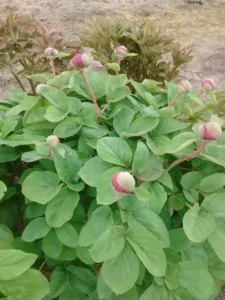Most people visiting this website come from the USA, google analytics tells me. Many will know how they are grown there and much information can be found in publications about peonies (Al Rogers’ ‘Peonies’ for example). But what about that other flower powerhouse on the other side of the ocean, Holland? Al Rogers once remarked that he had much difficulty in finding information about peonies in Holland as nearly nobody wanted to help him out. Well, we cannot help Al Rogers anymore as he is sadly no longer amongst us, but a very informative article just appeared in the trade journal ‘Greenity’ about the peony season for Dutch cutflower growers. The trade journal is highly recommended, but it’s doubtful that many people will be able to read it as it’s written in Dutch language. I’m a strong advocate for sharing information however, thus here’s my own translation of that article:
Peonies upholding themselves despite strangeness of season.
Peony season is past us. It has been a strange season looking back. Due to the weather the supply of heated greenhouses, unheated plastic tunnels and peonies grown outside was all pushed together. Even though many stems were available in a period of three weeks after May 15th, prices remained acceptable.
The capricious nature of growing peonies was obvious this year. In early spring the peony season was expected to be a late one. After all, winter had been rather wet and cold, but then March gave us one week of warmer weather and “everybody thought the start would be normal after all.” “But the fact is that you can only say something about the earliness or lateness of the season when it’s the end of April,” said Aad Vernooy, networkcoordinator peonies at LTO Glaskracht Nederland, a sectoral lobby organisation.
That appeared to be so. Because from then on temperatures remained above normal day and night and as a result all peonies resumed growth very fast. The flowers from the heated greenhouses were about one week later than usual, but the harvest from the unheated plastic tunnels followed just a few days later. Immediately followed by peonies growing outside, whilst normally there’s about 10 days between.
“Add to this that the different growing areas in the Netherlands started at more or less the same time,” says Marcel Salman, mediator at CNB (the largest flowerbulb mediating office) and peony grower in Noordwijk. All of this together resulted in three weeks cutting of an enormous amount of peony stems from the second half of May onwards.
Luck from Africa
You’d expect such an add-up to be detrimental for prices, but all peony stems sold well. Vernooy: “We had the sheer luck that just around that period there was a shortage of roses from Africa.” So suddenly there was more demand for peonies as they are a good alternative to roses. Thanks to this more peonies went to Russia, America and England. Added to this the explosion of peony flowers ready to harvest meant that many growers were unable to cope with all the work of cutting them and eventually harvested less flowers than normal. As growers can normally cut peonies of a single variety for about a week, this year it was only two or three days. This resulted in a large demand for additional workers but these could hardly be found. The effect of this was most visibly with the growers that have large acreages, says Salman. “Some of them were only able to go trough the fields once. The rest was left to remain on the fields due to lack of manpower.”
In general the quality of the peonies was good, although not especially so. Vernooy saw the effect of plants growing too fast, the inner quality of the flowerbuds was less: “There was less content in a normally well filled peony bud, most obvious in peony stems from the heated greenhouses.” The lesser growing power also gave us lighter, thinner stems. Due to the hot weather and shortage of workers this year they were usually cut in a very soft bud stage instead of too hard. Salman estimates that the proportion of buds opening too soon was somewhat higher than other years.
Cold store emptied earlier
Prices were in general reasonably good. The lowest day average at the auction was 0.30 € (0.34 $) per stem, Vernooy tells us. The price difference between peony varieties was large though. Some stems sold for 0.10 € (0.11 $); those were the lesser ones. The most expensive ones went above 2 euros (2.29 $) per stem, usually the newer varieties. Peonies grown outside fetched daily averages of between 0.32 and 0.34 € (0.37 – 0.39 $).
Salman remarks that prices are under pressure since the end of July. At that time there was a lot of supply from cold stored peonies. As the peonies went into cold storage less well due to the hot weather, he assumes growers emptied them earlier. Due to this the number of stems coming to market now are larger than normal. Salman: “Other years there are peonies from cold storage up until the end of August, but this year the cold stores will be empty sooner,” is his expectation. According to Salman this shows clearly in the prices fetched at the auction, as normally some of his peonies are sold for 1.50 to 2.00 € (1.72 – 2.29 $), they are now selling for 0.40 to 0.50 € (0.46 – 0.57 $). “That’s not a price that can make good the expensive storage, you need at least 1 € (1.14 $).” Salman didn’t see the price peaks that often occur from the end of May onwards.
Extending instead of advancing
That there’s growth in the cultivation of peonies, is well-known. The acreage devoted to peony cutflowers is growing exponentially, five years ago there were about 700 to 800 hectares (1,730 to 1,976 acres) of them, now it’s around 1.200 hectares (2,965 acres), Vernooy estimates. Of these, 900 hectares (2,223 acres) are being actively used for cutting, whilst another 300 hectares (741 acres) are young plantlets to be used in the future. Salman: “For sure, there will be more stems next year.” Still there’s usually some brake on the supply due to whatever reason. “Up until now we have had healthy growth and demand was always there.’ Demand also increases because the flower gets more and more popular and the assortment more diverse. “There are still ample sales opportunities for peonies, “ Vernooy is sure of. Growing demand is expected from Russia, Poland and Ukraine.
Vernooy and Salman also see opportunities for Dutch growers to extend the season. This could possibly be done through ULO-storage (Ultra Low Oxygen), which is still being experimented with. The season could be extended this way until halfway September, Vernooy thinks. Salman doubts whether this is the way to go. After all, these are not fresh flowers. If quality were to be paramount, it would be better if Dutch growers looked at extending the season through growing peonies in other countries. Salman: “Everybody in Europe is working on advancing the season, but then we’re all fishing the same pond.” New fishing waters might be found in countries where you could cut peonies from the beginning of July onwards, Vernooy thinks. “I’m thinking about the Baltics, thus countries like Estonia or Latvia.”
Less supply of peonies
According to FloraHolland (the world’s largest flower auction) this year during the period from week 1 (Jan 1-7) up until week 30 (Jul 23-29) more than 84.5 million peony stems were supplied. This is both Dutch and foreign supply and both auction and mediation combined. This means a decline of 2.2 percent compared to the same period in 2017. The supply from the Netherlands stands at 73 million stems, some 5 percent less than in 2017. The supply of peonies at the auction (more than 59.5 million) has declined whilst the supply of peonies sold through mediation (24 million) has increased.



















